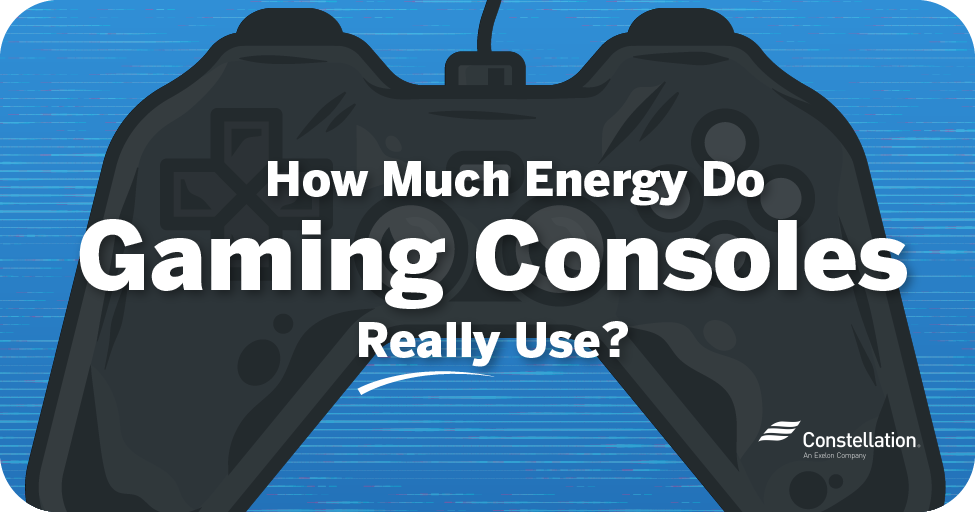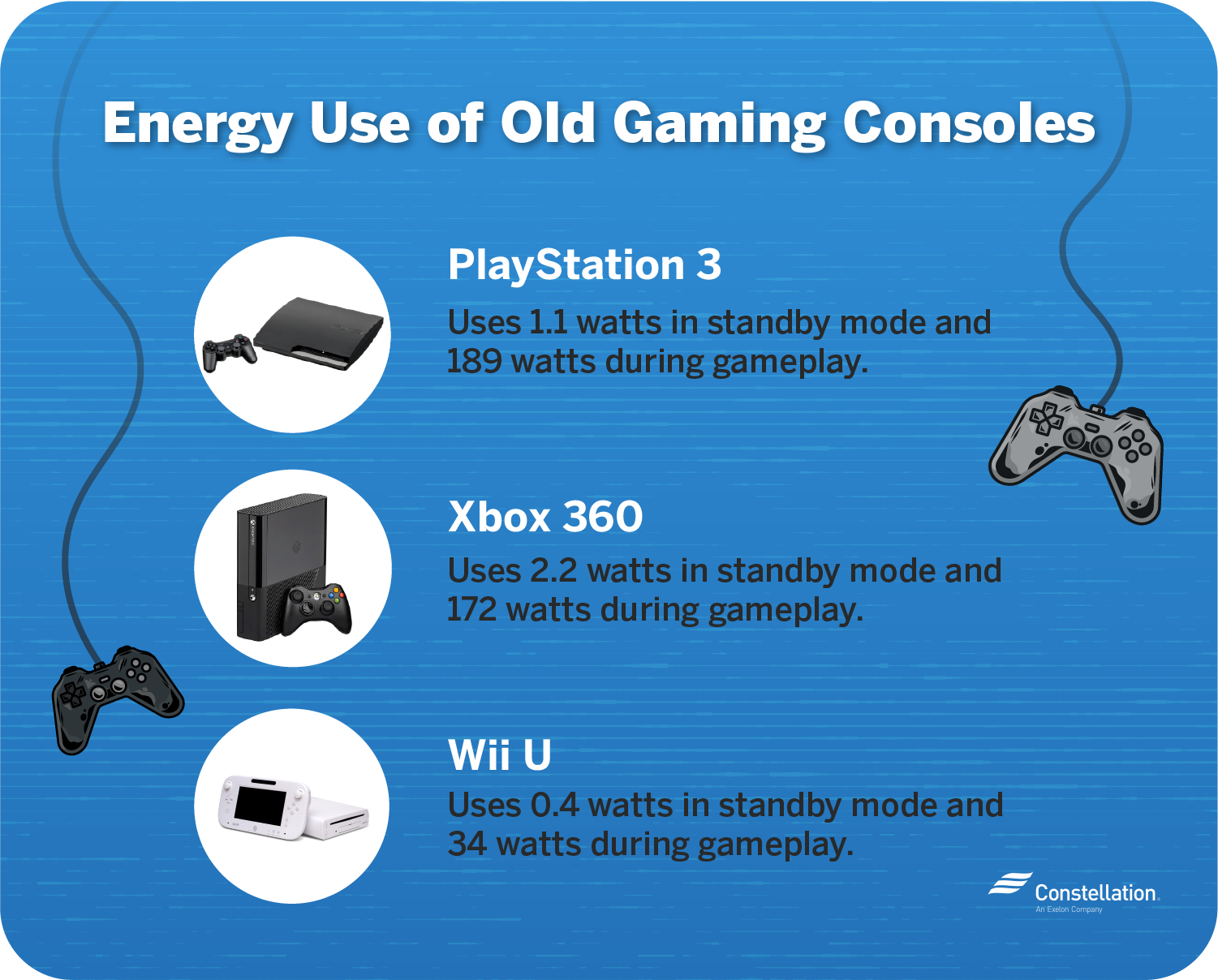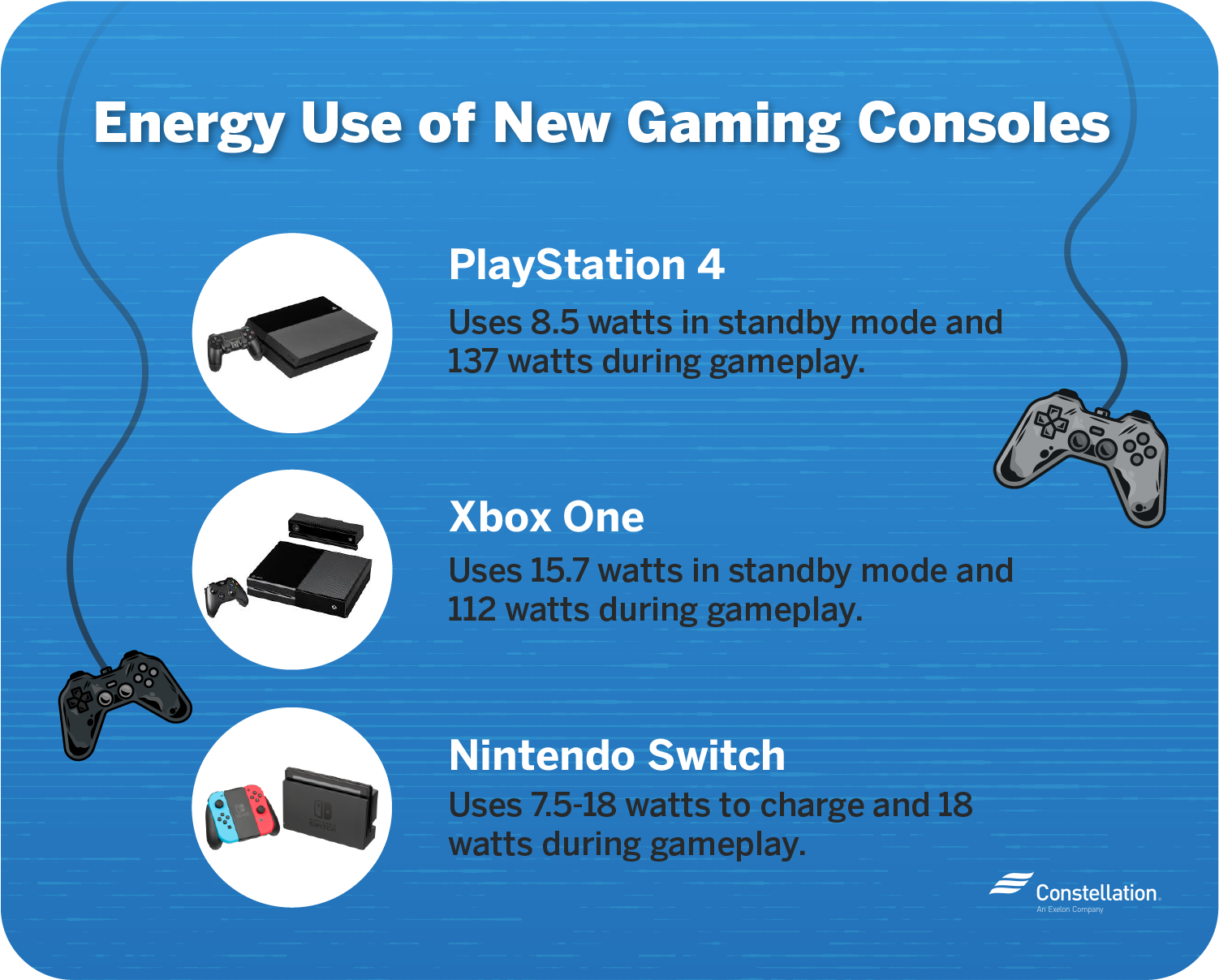
- Category:
Energy Efficiency -
Last updated:
January 19, 2022
How Much Energy Do Game Consoles Really Use?
Computer games have never been more popular. Two-thirds of Americans use PCs, consoles and streaming devices to play games. One study found that gaming accounts for 5% of residential energy use in California — the same amount of energy that 10 million refrigerators might use.
Video games have changed dramatically since Atari began marketing a game called Pong back in the 1970s. In fact, today’s games use 50 times more electricity. Especially now, as Americans are spending more time at home and keeping an eye on the budget, it’s a good idea for gamers to consider how much energy they use and how they could play more efficiently.
Energy use of old-gen game consoles

Advanced functionality comes at a cost. According to the National Resources Defense Council, which researched game console energy usage, the PlayStation 3 (PS3) consumed an average of 64 kilowatt-hours per year. The PlayStation 4 (PS4) uses double that at 181 kilowatt-hours per year.
PS3 wattage
The PS3 uses dramatically more power than the previous generation, the PS2, according to a 2013 game console energy consumption study.
Energy use of a PS3 in standby mode
PS3 standby power consumption clocks in at 1.1 watts.
Energy use of a PS3 during gameplay
Energy use of a PS3 during gameplay is measured at 189 watts.
Xbox 360 wattage
The Xbox 360 consumes an average of 70 kilowatt-hours per year.
Energy use of an Xbox 360 in standby mode
Energy consumption for the Xbox 360 in standby mode is 2.2 watts — double the PS3 standby power consumption.
Energy use of an Xbox 360 during gameplay
As with other units during gameplay, power use goes up. For the Xbox 360, it’s 172 watts.
Wii U wattage
The Wii U is one of the more energy-efficient gaming consoles among similar devices. It uses less than half the power of Xbox One and PS4.
Energy use of a Wii U in standby mode
Wii U in standby uses just 0.4 watts.
Energy use of a Wii U during gameplay
When the Wii U is in gameplay mode, the console uses 34 watts.
Energy use of next-gen game consoles

The new generation of game consoles can have a major impact on energy consumption in your home. The problem is in the hidden cost of standby power use.
A Natural Resources Defense Council study found that game console energy consumption in standby mode accounted for an outsize percentage of the total energy consumed by these devices. People use the standby mode because it allows the console to save your spot in a game, update functions and finish long downloads. You can start play instantly instead of waiting for these functions to complete after you power up.
PS4 wattage
The PS4 console burns more power than the PS3 on standby, but it’s more power-efficient during gameplay. Compared to comparable consoles, PS4 wattage is the highest of all devices during gameplay.
Energy use of a PS4 in standby mode
The PS4 in standby mode uses on average 8.5 watts.
Energy use of a PS4 during gameplay
PS4 energy use for gameplay was recorded at 137 watts.
Xbox One wattage
Xbox One wattage follows a pattern similar to other consoles — higher in standby and slightly more efficient during gameplay.
Energy use of an Xbox One in standby mode
The Xbox One in standby mode uses 15.7 watts — the most of all next-generation consoles.
Energy use of an Xbox One during gameplay
During gameplay, the Xbox One is more efficient than the PS4, using 112 watts.
Nintendo Switch wattage
The Nintendo Switch is the most energy-efficient gaming system. It operates on batteries, so it isn’t using energy from a wall socket during gameplay. Energy efficiency also means extended battery life for a better user experience.
Energy use of a Nintendo Switch while charging
Newer Nintendo Switches take between 3 and 3.5 hours to charge, drawing between 7.5 watts and 18 watts.
Energy use of a Nintendo Switch during gameplay
During gameplay on battery power, the Nintendo Switch uses 18 watts of energy.
Energy use of gaming computers
Gaming computers are high-powered PCs and laptops that gamers increasingly prefer. These machines are built for performance, not energy efficiency.
How much electricity does a gaming computer use? Although used by only 10% of gamers, gaming computers consume 40% of the energy consumed by gaming.
Why do gaming computers drain so much power?
The high performance that gamers crave comes at a cost. High-definition, extra-bright monitors and the souped-up graphics cards that run them are anything but energy-efficient. Gaming PC power consumption is also driven by long hours of use.
Upgrades can reduce gaming PC power consumption. Replacing your old hard drive with a solid-state drive (SSD) cuts the energy used by the drive itself and eliminates the need for a fan. You can also replace an old CRT with an LCD monitor with a good ENERGY STAR® rating.
7 ways to save energy with your game consoles
You don’t have to give up on gaming to save energy. Here are some practical tips for cutting game console energy consumption.
1. Activate power-saving settings
New features like voice control, gesture recognition, wireless controllers and the ability to stream content contribute toward the hidden energy costs of gaming consoles. Gamers might not know that these features can draw power even when they’re not using them.
The ENERGY STAR® website, run by the U.S. Environmental Protection Agency and U.S. Department of Energy, offers detailed instructions for setting up the most popular game consoles to minimize energy consumption without affecting gameplay. Some devices even have an energy-saving power mode.
2. Keep your consoles updated
Console updates can often optimize settings and may include power-saving features, like the ability to automatically shut down your system when inactive.
3. Turn controllers off when not in use
Automatic shutdown functions can save power, but not all gaming consoles have them. Be proactive and turn off your console and its controllers when you’re not using them to cut down on energy waste.
4. Unplug when you can
Like many advanced electronics, gaming consoles can draw power even when turned off, which adds up over time. Unplugging them when not in use cuts game console energy consumption that’s pure waste.
5. Avoid streaming on consoles
The energy costs of streaming on game console systems can be considerable. Game consoles are not optimized for streaming like a streaming device such as an Apple TV or Roku.
6. Upgrade your hardware
As we explained above, upgrading hardware and components can cut gaming PC power consumption. Berkley Lab conducted a number of experiments for “greening the beast” and offers energy-saving configuration tips.
7. Conduct a home energy audit
A professional home energy audit is a thorough inspection of how energy is used — and sometimes wasted — in your home. Including your game console usage in a home energy audit will give you the information you need to find ways to be more efficient and cut overall energy usage.
Gaming has become a leading source of entertainment. And as gaming systems grow more sophisticated, consumer awareness of the energy consumption of game consoles and gaming PCs is also growing. Indeed, manufacturers are feeling the pressure to make their new systems still under development more energy-efficient, especially in standby mode.
With improved awareness, smarter systems and thoughtful habits, energy waste in gaming can be reduced. And by removing the stress of higher energy use, gamers can better enjoy their favorite pastime.




